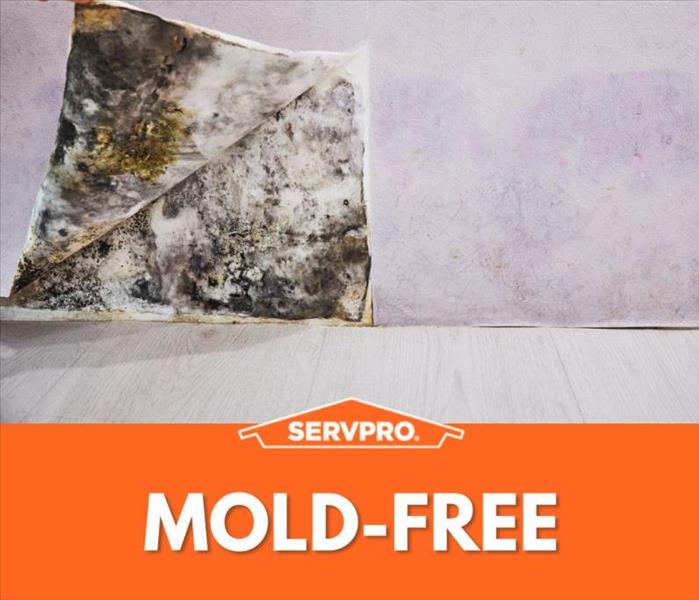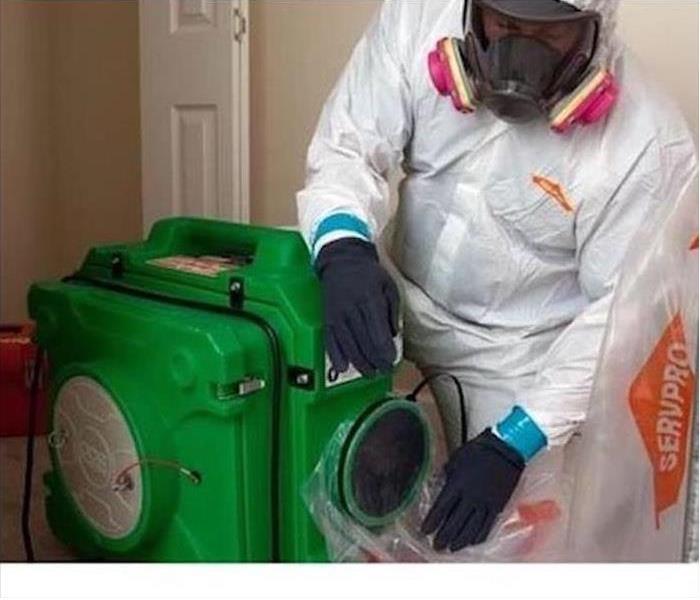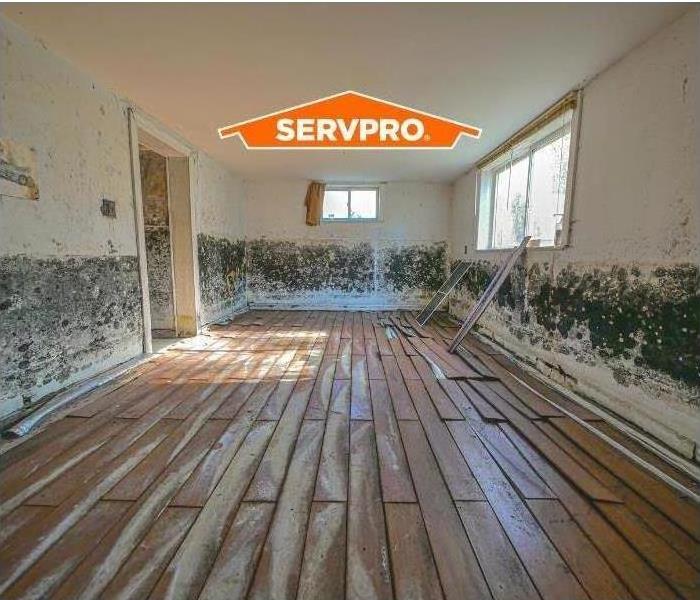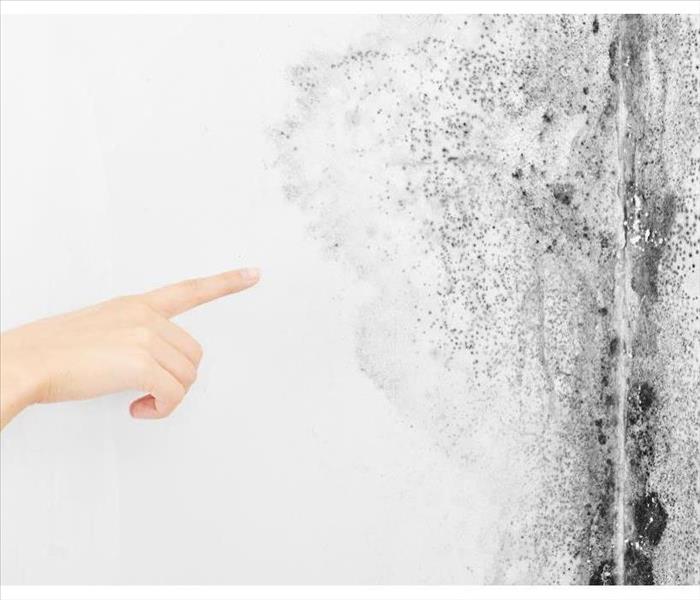Understanding the Diverse Causes of Mold Formation | SERVPRO of St. Charles City
4/11/2024 (Permalink)
 SERVPRO of St. Charles City is here to help with mold damage and remediation
SERVPRO of St. Charles City is here to help with mold damage and remediation
Mold is a common and potentially problematic issue that can affect homes and buildings. Its presence not only poses risks to the structure but can also have adverse effects on the health of those living or working within the space. To effectively combat mold, it is crucial to understand the various ways it can form in different environments.
1. Excess Moisture
Mold thrives in damp and humid conditions, making excess moisture the primary factor in mold formation. Several scenarios contribute to elevated humidity levels:
a. Leaky Roofs and Windows:
- Leaks in roofs or around windows allow water to seep into the structure, creating an ideal environment for mold growth.
b. Poor Ventilation:
- Inadequate ventilation can lead to stagnant air, allowing moisture to accumulate and mold to develop.
c. Plumbing Issues:
- Leaky pipes, whether hidden or visible, can introduce water into walls, floors, and ceilings, providing a breeding ground for mold.
d. Basement Dampness:
- Basements are prone to dampness, especially if they are not properly waterproofed. This can lead to mold formation on walls and floors.
2. Floods and Water Damage
Homes and buildings that have experienced flooding or significant water damage are at an increased risk of mold formation. The prolonged presence of moisture following a flood creates conditions conducive to mold growth. Quick and thorough drying is essential in such situations.
3. Condensation
Condensation occurs when warm, moist air comes into contact with a cold surface, leading to the formation of water droplets. Areas prone to condensation include:
a. Windows:
- Condensation on windows can create an environment where mold can thrive on window sills and frames.
b. Cold Walls:
- Exterior walls that are not properly insulated can attract condensation, fostering mold growth.
c. Cold Water Pipes:
- Pipes carrying cold water can accumulate condensation, potentially leading to hidden mold growth.
4. High Humidity
Regions with naturally high humidity levels are more susceptible to mold problems. Coastal areas or places with tropical climates often face challenges in maintaining low humidity, making them prone to mold-related issues.
5. Improperly Sealed Buildings
Buildings that are not properly sealed are more susceptible to external moisture infiltration. This can happen through gaps in walls, roofs, or windows, providing an entry point for water and creating an environment conducive to mold formation.
6. Damp Construction Materials
During construction or remodeling, if building materials are exposed to rain or high humidity and are not adequately dried before installation, they can harbor mold. This hidden mold can later become a problem as the building ages.
7. Airborne Mold Spores
Mold spores are naturally present in the air both indoors and outdoors. While they are usually harmless in low concentrations, when provided with the right conditions, these spores can settle and multiply, leading to mold infestation.
8. Household Activities
Certain household activities can inadvertently contribute to mold growth:
a. Drying Clothes Indoors:
- Hanging wet clothes to dry indoors can introduce excess moisture into the air.
b. Cooking without Proper Ventilation:
- Cooking, especially boiling or frying, releases moisture into the air. Without proper ventilation, this can lead to mold problems.
c. Indoor Plants:
- Overwatering indoor plants can increase humidity levels, creating an environment favorable to mold.
Preventing and Addressing Mold Issues:
Understanding the various causes of mold formation is crucial, but so is taking preventive measures and addressing existing problems promptly. Here are some preventive steps and solutions:
a. Maintain Proper Ventilation:
- Ensure that your home or building is adequately ventilated to prevent the accumulation of stagnant air and moisture.
b. Address Leaks Promptly:
- Repair any leaks in the roof, windows, or plumbing as soon as they are identified.
c. Use Dehumidifiers:
- Employ dehumidifiers in areas prone to high humidity, such as basements or bathrooms.
d. Improve Insulation:
- Properly insulate walls and windows to reduce the likelihood of condensation.
e. Regular Maintenance:
- Conduct regular inspections of the building, checking for leaks, and ensuring proper drainage.
f. Promptly Address Water Damage:
- If your home has experienced flooding or water damage, take immediate steps to dry and sanitize the affected areas.
g. Control Indoor Humidity:
- Maintain indoor humidity levels between 30-50% to discourage mold growth.
h. Properly Seal Buildings:
- Ensure that the building is properly sealed to prevent water infiltration.
i. Use Mold-Resistant Products:
- Consider using mold-resistant building materials, especially in areas prone to dampness.
j. Professional Mold Remediation:
Conclusion: Vigilance and Proactivity are Key
Mold formation can result from a combination of factors, making it essential to remain vigilant and proactive in preventing and addressing potential issues. By understanding the diverse causes of mold growth, individuals can take steps to create an environment that is inhospitable to mold, ensuring the health and longevity of their homes and buildings. If mold damage becomes an issue, don’t hesitate to call the remediation professionals at SERVPRO of St. Charles City.
Defeating Mold Damage: Expert Strategies for a Mold-Free Home | SERVPRO of St. Charles
9/27/2023 (Permalink)
 SERVPRO of St. Charles is your trusted choice for mold removal and remediation. Call us today at (636) 926-0033
SERVPRO of St. Charles is your trusted choice for mold removal and remediation. Call us today at (636) 926-0033
If you’ve ever experienced issues with mold, you know that it’s more than just an unsightly nuisance.
Mold can silently wreak havoc on your health and property. In this extensive guide, we will delve deep into the dangers of mold, how to detect its presence, and the indispensable role of professional mold remediation services. Whether you're dealing with mold removal, mold remediation, or the costs involved, this comprehensive resource will equip you with vital knowledge to protect your St. Charles, Missouri property.
Understanding Mold
Mold, a type of fungus, serves a vital role in nature by breaking down organic matter. However, when it infiltrates our indoor spaces, it can cause a multitude of issues. Let's explore the key aspects of mold:
• Health Risks: Exposure to mold can lead to a range of health problems. Mold spores are allergens that can trigger asthma, allergies, respiratory issues, and skin irritations.
• Black Mold (Stachybotrys chartarum): Often dubbed "toxic black mold," this species is particularly notorious for its mycotoxins, which can lead to severe health problems when inhaled or touched.
• Property Damage: Mold thrives on organic materials like wood, drywall, and insulation, causing structural damage and costly repairs.
• Airborne Allergens: Mold releases allergenic proteins that can initiate allergies, even in individuals who haven't experienced them before.
• Mold Odor: Mold produces a distinct, musty odor that permeates the environment, making your indoor space uncomfortable and unwelcoming.
Identifying Mold Damage
Early detection is crucial for effective mold remediation. In many cases, it will be necessary to call a professional mold remediation company for mold testing. Mold often grows in concealed, inaccessible areas, rendering it invisible without professional help. Here are some telltale signs of mold damage:
• Visible Mold Growth: The most apparent indication is the presence of visible mold. It can manifest as fuzzy, discolored patches on walls, ceilings, or other surfaces.
• Musty Odor: An enduring, musty smell is a strong indicator of mold growth, even if you can't see it. This scent is a result of the volatile organic compounds (VOCs) emitted by mold.
• Water Damage History: Properties with a history of water damage, flooding, or leaks are at higher risk for mold growth. Mold thrives in moist environments.
• Health Symptoms: If occupants experience unexplained health symptoms like coughing, sneezing, congestion, or skin irritation that improve when leaving the property, mold may be the culprit.
• Peeling Paint or Wallpaper: Mold can cause paint or wallpaper to peel or bubble as it grows beneath these surfaces.
The Mold Remediation Process
Mold remediation is a complex, regulated process aimed at identifying, containing, and eliminating mold to ensure the safety and health of occupants. Here's an overview of the standard mold remediation process:
Mold Inspection and Assessment
Before embarking on the remediation journey, a certified mold inspector evaluates the extent of the mold damage. They identify the type of mold, its location, and the underlying moisture source that fueled its growth.
Containment
Effective containment is vital to prevent mold spores from migrating to uncontaminated areas. Professionals utilize plastic sheeting and negative air pressure machines to isolate the affected area.
Mold Removal
The next stage involves the physical mold removal. Depending on the infestation's scale, this may entail removing and disposing of materials like drywall, insulation, or carpeting. Professionals wear personal protective equipment (PPE) and adhere to stringent safety protocols throughout this phase.
Mold Cleaning and Sanitization
All surfaces within the containment area undergo thorough cleaning and sanitization, utilizing specialized equipment and antimicrobial agents to eliminate any lingering mold spores.
Drying and Dehumidification
To prevent future mold growth, experts employ industrial-grade dehumidifiers and air movers to fully dry the affected space. Addressing the moisture source is pivotal in mold prevention.
Post-Remediation Testing
After remediation, a certified mold testing company may perform post-remediation testing to confirm the successful resolution of the mold issue and ensure safe indoor air quality.
Assessing Mold Remediation Costs
The cost of mold remediation can vary considerably based on factors such as the extent of the infestation, the type of mold, and its location within the property. Several factors may influence mold remediation costs:
• Infestation Size: Larger mold infestations typically necessitate more extensive remediation efforts, leading to higher costs.
• Location Complexity: Mold in confined or challenging-to-reach areas may require additional labor and equipment, impacting the overall cost.
• Mold Type: Hazardous molds, including toxic black mold, may necessitate more elaborate safety measures, driving up costs.
• Structural Damage: Mold that has caused structural deterioration may entail expensive repairs, such as drywall replacement or subfloor restoration.
• Insurance Coverage: Depending on your insurance policy, a portion or the entirety of the remediation costs may be covered, reducing your financial burden.
It's crucial to remember that while mold remediation costs are a concern, the health and safety of occupants should take precedence. Cutting corners during mold remediation can result in incomplete removal and recurrent mold problems.
A Mold Remediation Company You Can Trust: SERVPRO of St. Charles
When seeking mold remediation services, it's essential to choose a reputable and experienced mold removal company. Here are some essential considerations for selecting the right professionals:
• Certifications: Seek out companies and technicians certified by renowned organizations such as the Institute of Inspection, Cleaning and Restoration Certification (IICRC) or the National Association of Mold Professionals (NAMP).
• References: Request references or peruse online reviews on sites such as Google or Yelp to gauge the company's reputation and customer satisfaction.
• Experience: Opt for a company with extensive experience in mold remediation. Their knowledge and expertise will be indispensable in handling your specific situation.
• Transparency: The chosen company should provide a detailed scope of work, including a written estimate and a clear explanation of the
In your quest for mold removal and remediation services, consider the mold remediation experts at SERVPRO of St. Charles, experienced professionals dedicated to ensuring your safety and restoring your peace of mind.
Preventing Future Mold Infestations
After successfully remedying mold, it's imperative to implement preventive measures to stave off future mold issues. Here are some strategies to maintain a mold-free environment:
• Moisture Control: Identify and rectify moisture sources, such as leaks, plumbing issues, or inadequate ventilation. Keeping indoor humidity levels below 60% is a potent preventive measure.
• Routine Maintenance: Perform regular inspections and maintenance to spot and address potential problem areas early, before they become breeding grounds for mold.
• Proper Ventilation: Ensure ample ventilation in moisture-prone zones like bathrooms, kitchens, and basements. Consider using exhaust fans and dehumidifiers if necessary.
• Effective Drainage: Channel rainwater away from your property by maintaining gutters, downspouts, and proper grading.
• Timely Repairs: Swiftly attend to water damage issues. Do not delay in fixing leaks, roof damage, or plumbing problems that can spawn mold growth.
Conclusion
Mold damage is a formidable adversary that poses health risks, property damage, and persistence without proper management. Mold removal and remediation are tasks best entrusted to certified professionals who possess the expertise, equipment, and experience to ensure thorough and safe mold cleanup. By understanding the perils of mold, recognizing its presence, and taking proactive measures, you can safeguard your property and the well-being of your loved ones. Always remember, when it comes to mold, prevention is paramount, but prompt and effective remediation is your first line of defense.
SERVPRO of St. Charles is here to help with your mold remediation services needs. We have 24/7 emergency services and are always available for mold testing and mold estimates. Call us today at (636) 926-0033.
Should You Get Your St. Charles Home Tested or Sampled for Mold?
3/13/2023 (Permalink)
 SERVPRO of St. Charles is here to help with all your mold remediation services.
SERVPRO of St. Charles is here to help with all your mold remediation services.
When is time to get a sample for mold? If visible mold growth is present, sampling is unnecessary.
Surface sampling may be useful to determine if an area has been adequately cleaned or remediated. Sampling for mold should be conducted by professionals who have specific experience in designing mold sampling protocols, sampling methods and interpreting results.
Sample analysis should follow analytical methods recommended by the American Industrial Hygiene Association (AIHA), the American Conference of Governmental Industrial Hygienists (ACGIH), or other professional organizations.
Are there federal regulations or standards regarding mold testing?
Standards or Threshold Limit Values (TLVs) for airborne concentrations of mold, or mold spores, have not been set. Currently, there are no EPA regulations or standards for airborne mold contaminants.
Understanding Mold
When water intrudes into your property, mold growth can start in as little as 48 hours. Consider the following mold facts:
- Mold is present almost everywhere, indoors and outdoors.
- Mold spores are microscopic, float along in the air, and may enter your home through windows, doors, or AC/heating systems or even hitch a ride indoors on your clothing or a pet.
- Mold spores thrive on moisture. Mold spores can quickly grow into colonies when exposed to water. These colonies may produce allergens and irritants.
- Before mold remediation can begin, any sources of water or moisture must be addressed. Otherwise, the mold may return.
- Mold often produces a strong, musty odor, and that odor can lead you to possible mold problem areas.
- Even higher-than-normal indoor humidity can support mold growth. Keep indoor humidity below 45 percent.
The Mold Remediation Process
Every mold damage scenario is different and requires a unique solution, but the general mold remediation process stays the same. Learn more about our mold remediation process.
- Emergency Contact - (636) 442-0847
- Inspection and Mold Damage Assessment
- Mold Containment
- Air Filtration
- Removing Mold and Mold-Infested Materials
- Cleaning Contents and Belongings
What to Do If You Find Mold
2/10/2022 (Permalink)
Mold is a terrifying word to many property owners. A word with the potential to cause a ton of problems. What should be done if you find or suspect mold in your home or business? Let’s start with some facts about mold.
Mold Facts:
- Mold is all over, inside and out.
- Mold spores are microscopic, floating aloft into your home through windows, doors, or AC/heating systems.
- Mold spores thrive on moisture, quickly growing into colonies when exposed to water. These colonies may produce health effects.
- Before mold remediation can begin, any sources of water or moisture must be addressed. Otherwise, the mold may return.
- Mold often produces a strong, musty odor and can lead you to possible mold problem areas.
- Higher-than-normal indoor humidity can support mold growth, so keep indoor humidity below 45 percent.
- Significant mold growth can occur in 48-72 hours.
- Mold may present a greater risk to children, the elderly, and anyone with respiratory problems.
- A strong, musty odor may indicate hidden mold behind drywall or under carpeting.
How do you know if you have mold? One of the easiest ways to identify if your property has mold damage is seeing the actual mold spores. However, this is often a sign of a larger problem and should be properly investigated by a professional. Another sign can be if you notice a bit of moldy or musty smell, which can also indicate there may be a mold issue.
It’s also a good idea to check where you know water has leaked in the past. Past flooding can also lead to mold issues, becoming a problem a long after if the initial water damage was not thoroughly dried. Be sure to check previously flooded areas for mold.
One of the first steps before remediation of your mold affected area is to stop the source. Many times, mold is from a small plumbing or roof leak. The source will need to be repaired or the mold will simply come back again and again. If you’re not sure of the moisture source, it’s best to hire a professional such as SERVPRO of St. Charles City for help.
Our technicians can inspect your home or business. SERVPRO of St. Charles City, SERVPRO of St. Peters and SERVPRO of Dardenne Prairie/Weldon Springs has the training, protective gear, and specialized equipment necessary to handle your mold problem.
We are here to help. Give SERVPRO of St. Charles City a call today: (636) 926-0033.
Where To Look for Mold in Your Home
5/30/2019 (Permalink)
 What are mold and mildew
What are mold and mildew
If you know where to look for mold, you can stop mold damage before it gets too serious. In O'Fallon,MO, this is an important issue for any homeowner. Mold can be predictable, so it’s a good idea to educate yourself about how mold works in order to stay on top of it.
What Are Mold and Mildew?
Mold is a type of fungus that can cause structural damage to your home. It reproduces via microscopic airborne spores, so it can only be seen once it begins growing as a colony. Mold growth has a fuzzy appearance due to multicellular filaments known as hyphae and can present in a variety of colors, such as black, brown, blue, green, yellow, pink and white. It emits a distinct musky odor. Mildew growth is a specific type of mold that appears chalky rather than fuzzy and is usually white or gray. It does not cause as much damage as mold.
Where Does Mold Like To Hang Out?
Since moisture facilitates mold, it is best to identify any sources of this in your home, such as leaky pipes. Mold likes to feed on organic material, such as drywall, paper, wood and fibers that have been exposed to water. You should routinely inspect the following places for mold damage.
- Basement
- Kitchen
- Bathroom
- Area near HVAC
- Anywhere that appears damp
What Should You Do When You Find It?
If you locate evidence of damage from mold in your inspections, the first thing you should do is have the problem assessed by professionals. They can recommend how to move forward via a mold remediation process. Mold can never be totally removed because it is a natural component of the air around you, but it can be managed to stay within appropriate levels. You should not attempt to remove mold on your own.
Knowing where to expect mold in your home is an important first step in preventing mold damage. Remember, mold loves moisture.





 24/7 Emergency Service
24/7 Emergency Service



